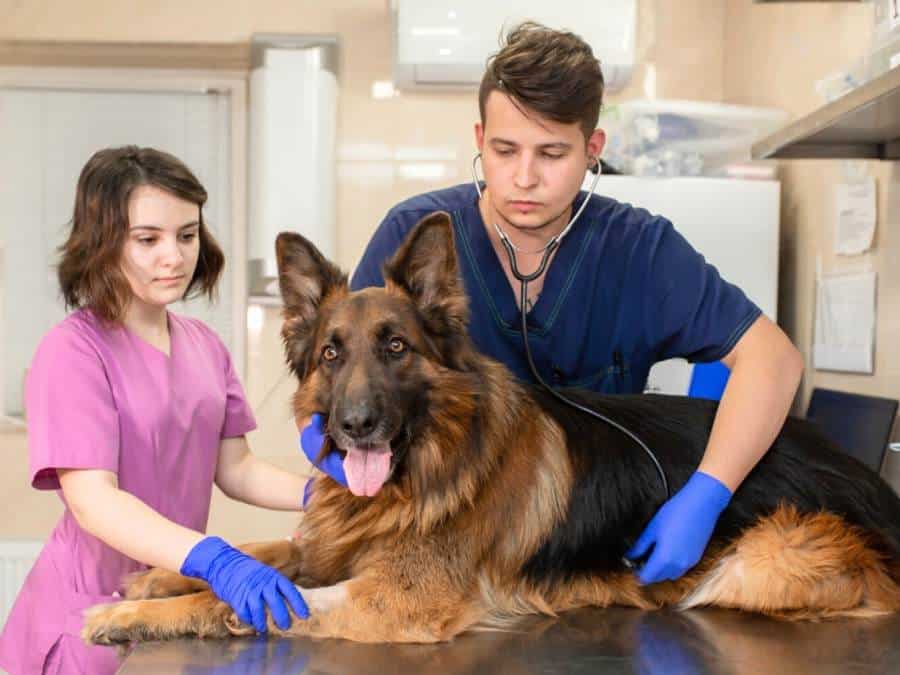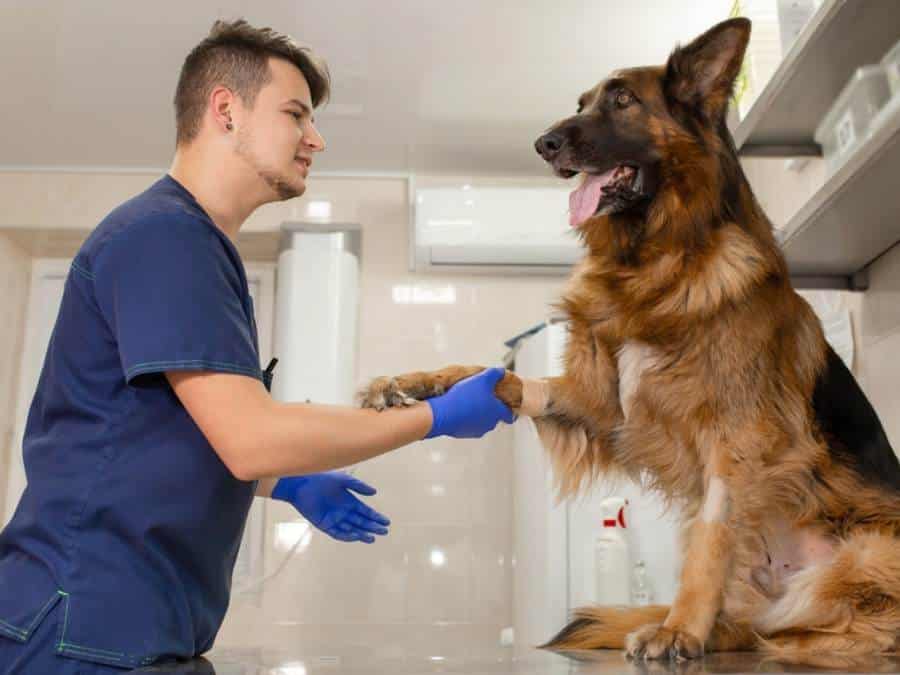Hot spots in German Shepherds can start small but quickly worsen if left untreated. They often occur due to a combination of factors, including allergies, poor grooming habits, trauma, or underlying health issues.
Early detection and prevention play a vital role in managing these troublesome spots effectively.
By learning how to identify the signs of hot spots and taking the necessary steps for cleaning and care, you can help eliminate infections and provide relief for your beloved German Shepherd.
What are Hot Spots in German Shepherds?
German Shepherd hot spots, also known as acute moist dermatitis or polytraumatic dermatitis, are areas of inflamed and infected skin that can cause discomfort and irritation to our furry friends. Hot spots often appear as red, moist, and painful lesions on the dog’s skin.
GSDs are more prone to developing hot spots due to their dense double coat. The thick fur can trap moisture against the skin, creating a warm and humid environment ideal for bacterial growth.
Factors such as allergies, flea infestations, poor grooming habits, or underlying health issues can further contribute to the development of hot spots in German Shepherds.
Check out the following pictures of German Shepherd hot spots before we discuss its treatment at home.


How to Treat German Shepherd Hot Spots at Home?
While home remedies can help provide some relief for mild cases of hot spots in dogs, it’s crucial to note that severe or persistent cases should be evaluated by a veterinarian for proper diagnosis and treatment.
Here are some steps to follow to treat German Shepherd hot spots at home:
- To start, you’ll want to trim or shave the fur around the hot spot on your German Shepherd. This will help the medication reach the affected skin and speed up healing.
- After that, use this Sulfodene Hot Spot and itch Relief Medicated Spray to clean the affected area. Make sure to let it dry completely so your dog doesn’t lick it off.
- Once dry, apply this Hot Spot Ointment that will protect the skin from germs, provide a soothing moisturizing barrier, and prevent any pain.
- Make sure to clean the hot spot every day using the antiseptic spray, followed by the pain-preventing ointment. This will help your dog heal faster.
- If the hot spot is large or oozing, you can wrap it securely using these Self Adhesive Bandage Wraps. Remember to change the dressing daily after cleaning and reapplying the medication.
- To prevent infection and keep your dog from messing with the treatment, consider using this Comfortable Soft Dog Cone Collar. This will ensure that the hot spot treatments stay on the skin and your dog doesn’t further irritate the area.
If the skin problem doesn’t improve within 3 days or if your dog shows other signs of illness, it’s important to consult your veterinarian for further guidance.
In most cases, the hot spot can go away within just 3 to 8 days if you treat it consistently.
Where do hot spots occur on German Shepherds?
Hot spots in dogs can occur anywhere on the body but are often found in areas that are easily reachable for licking, scratching, or biting. Moreover, hot spots are more commonly found in areas where moisture accumulates or there is friction.
Hot spots on German Shepherds can be found on various parts of their body, including the ears, chest, hips, limbs, and paws.
Common locations for hot spots include:
- Below the ears on the face
- ears
- sides of the chest
- flanks between the hips and ribs
- paws
- rump, and
- rectum
In addition to these common areas, it’s essential to remember that hot spots can develop almost anywhere on your German Shepherd’s body. They don’t discriminate! It could be their backside, belly, neck – you name it!
RELATED: German Shepherd Ear Mites

Symptoms of Hot Spots in German Shepherds
Recognizing the signs of hot spots in German Shepherds is crucial for their well-being. These irritated areas on the skin can cause discomfort and pain for our furry friends.
Here are some signs to watch out for:
- Redness and swelling: Hot spots often appear as red, swollen patches on the skin. These areas may be warm to the touch and may feel painful or itchy for the animal.
- Moisture and discharge: Hot spots are characterized by oozing or discharge from the affected area. The skin may appear wet or matted due to the excessive moisture.
- Hair loss: As hot spots progress, they can cause hair loss in the surrounding area. The affected patch may become bald or have thinning hair.
- Intense itching: Hot spots can be incredibly itchy, leading pets to scratch, lick, or chew at the affected area excessively. This can further irritate the skin and worsen the condition.
- Foul odor: Due to the moisture and bacterial growth associated with hot spots, an unpleasant odor may emanate from the affected area.
- Pain and discomfort: Hot spots can be painful for pets, causing them to exhibit signs of discomfort such as restlessness, whimpering, or reluctance to be touched.
- Rapid development: Hot spots can appear suddenly and progress rapidly. They may start as small, localized areas but can quickly spread and enlarge if left untreated.
- Behavioral Changes: Pets with hot spots may exhibit changes in behavior. They may become irritable, agitated, or exhibit signs of depression due to the discomfort they are experiencing.
- Restlessness: Dogs with hot spots may become restless and have difficulty settling down due to the irritation.
- Avoidance of touch: Dogs may shy away from being touched, especially in the region where the hot spot is located.
If you notice any of these symptoms on your pet’s skin, it is important to seek veterinary care promptly.
Your veterinarian can properly diagnose the hot spot and recommend appropriate treatment, which may include cleaning the affected area, prescribing antibiotics or topical medications, and addressing any underlying causes or contributing factors.
RELATED: German Shepherd Pyoderma Cellulitis

Causes Behind German Shepherd Hot Spots
Hot spots are painful and itchy sores can appear suddenly and can be quite bothersome for your furry friend. Understanding the causes behind hot spots can help you prevent and treat them effectively. Here are some common causes:
1. Allergies: German Shepherds are prone to allergies, which can trigger hot spots. These allergies can be caused by environmental factors such as pollen, dust mites, or certain foods.
Check out this comprehensive guide on German Shepherd allergies to gain insights into various causes and treatments associated with allergies in these dogs.
2. Fleas and ticks: Infestation of fleas and ticks (Flea Allergy Dermatitis) can lead to hot spots. These parasites irritate the skin, causing your German Shepherd to scratch and bite excessively, resulting in hot spots.
3. Moisture and humidity: German Shepherds have a thick double coat, which can trap moisture close to the skin. This creates a perfect environment for bacteria to thrive, leading to hot spots.
4. Bacterial infections: Bacteria on the skin surface can proliferate, leading to infections that contribute to hot spot development. Moist environments, such as after swimming or in the presence of skin folds, can increase the risk.
5. Yeast infections: Yeast overgrowth on the skin, often associated with underlying conditions like allergies, can contribute to hot spot formation.
6. Skin irritations: Any irritation to the skin, such as a cut, scrape, or insect bite, can become a hot spot if not properly treated. It’s important to keep an eye on any skin abnormalities and promptly treat them to prevent hot spots from developing.
RELATED: Why Does My German Shepherd Itch So Much
7. Poor grooming: Neglecting regular grooming can contribute to the development of hot spots in German Shepherds. Mats and tangles in the fur can trap moisture and irritants, leading to hot spots. Regular brushing and bathing can help prevent this.
8. Stress, anxiety, or boredom: Just like humans, dogs can experience stress and anxiety, which can weaken their immune system and make them more susceptible to hot spots.
9. Underlying health conditions: Certain health conditions, such as hypothyroidism or autoimmune disorders, can make German Shepherds more prone to developing hot spots.
10. Underlying Skin Conditions: Certain skin conditions, such as seborrhea or dermatitis, can make a dog more susceptible to developing hot spots.
11. Foreign objects or irritants: Anything that irritates the skin, such as burrs, thorns, or chemicals, can contribute to the development of hot spots.
Preventing hot spots often involves addressing the underlying cause. This may include regular grooming, flea control, managing allergies, and providing a healthy, balanced diet.
If a hot spot does develop, prompt veterinary attention is important to properly diagnose the cause and provide appropriate treatment to alleviate the dog’s discomfort and prevent further complications.

How to Diagnose Hot Spots in German Shepherds?
Hot spots in German Shepherds can be easily identified by a veterinarian. However, determining the underlying problem usually involves a process of elimination to find and treat the main cause.
During a vet examination, they will check for “flea dirt,” which is dried blood left by fleas. This is usually a sign of a flea infestation, and the vet will prescribe treatments for parasites, like flea prevention.
In some cases, the vet may examine skin scrapings under a microscope to determine if your dog has yeast dermatitis, or parasitic, or bacterial infection that could be causing their skin issues.
Based on the results, the vet will prescribe the appropriate medication. If an allergy is suspected, allergy testing may be necessary to identify what your German Shepherd is allergic to.
Lastly, if all other methods fail to pinpoint the primary cause, the vet may use laboratory testing to check for specific metabolic or immune disorders that could be the root cause of your dog’s skin problems.
Click here to learn more about several other German Shepherd diseases and their treatments.
When to Consult a Veterinarian?
While some mild cases of hot spots can be treated at home, there are certain situations where it is important to consult a veterinarian.
Here are some instances when you should consider seeking professional help for your dog’s hot spots:
- Severe inflammation or infection: If the hot spot is large, spreading rapidly, or if there are signs of infection such as pus, a foul odor, or increased redness, professional care is necessary.
- Systemic symptoms: If your dog shows signs of systemic illness such as lethargy, fever, loss of appetite, or other unusual behavior, it indicates that the condition may be more severe and requires immediate veterinary attention.
- Persistent itching or discomfort: If your dog continues to excessively lick, bite, or scratch at the hot spot despite home treatment, or if the behavior seems to be escalating, it’s time to see a vet.
- Underlying causes: If the hot spot is recurrent or if you suspect an underlying cause such as allergies, parasites, or skin infections, it’s important to have the vet perform a thorough examination and possibly run diagnostic tests.
- Worsening of symptoms: If you notice that the hot spot is not improving or if it worsens despite your attempts at home care, professional intervention is needed.
- Changes in eating or drinking habits: If your dog experiences changes in appetite, water intake, or any digestive issues in conjunction with a hot spot, consult with a vet.
- Recurring hot spots: If your dog experiences recurrent hot spots, it is essential to consult a veterinarian.
Remember, hot spots can be a symptom of an underlying problem, and addressing the root cause is crucial for effective treatment and prevention of recurrence. Your veterinarian can provide a proper diagnosis, prescribe appropriate medications, and offer guidance on preventing future hot spots.

Professional Veterinary Treatments
Professional veterinary treatments for hot spots (acute moist dermatitis) in German Shepherds may involve a combination of the following approaches, depending on the severity and underlying cause of the condition:
1. Physical examination: The veterinarian will conduct a thorough physical examination to assess the extent of the hot spot, check for signs of infection, and evaluate the overall health of the dog.
2. Cleaning and trimming: The vet will clean the affected area to remove debris, discharge, and bacteria. Trimming the hair around the hot spot is often necessary to promote air circulation and facilitate treatment.
3. Topical medications: Veterinarians may prescribe or recommend topical treatments such as medicated shampoos, sprays, or ointments containing antibiotics, antifungals, or corticosteroids to reduce inflammation and control infection.
4. Oral medications: In cases of severe inflammation or infection, veterinarians may prescribe oral medications such as antibiotics or steroids to address the underlying cause and alleviate symptoms.
5. Elizabethan collar: To prevent further licking, biting, or scratching of the affected area, veterinarians may recommend using an Elizabethan collar (a cone-shaped collar) to restrict the dog’s access to the hot spot.
6. Allergy management: If allergies are identified as the underlying cause, the vet may recommend allergy testing to identify specific triggers. Allergy management may involve dietary changes, hypoallergenic diets, or the use of antihistamines.
7. Flea control: If fleas are contributing to the hot spot, the vet will recommend a suitable flea control program, which may include topical or oral flea preventatives.
8. Systemic medications: In some cases, systemic medications may be necessary to address underlying issues such as bacterial or yeast infections. These medications can include oral antibiotics or antifungal drugs.
9. Diagnostic tests: If the hot spot is recurrent or if an underlying cause is suspected, the veterinarian may perform diagnostic tests such as skin scrapings, cytology, or allergy testing to identify the specific cause.
It’s important for pet owners to follow the veterinarian’s instructions closely and complete the prescribed course of treatment. Additionally, addressing any underlying causes is crucial for preventing the recurrence of hot spots in the future.

How to Prevent Hot Spots in German Shepherds?
Preventing hot spots in dogs involves addressing underlying causes and implementing good hygiene and grooming practices. Here are some tips to help prevent hot spots:
1. Regular grooming: Keep your dog’s coat clean and well-groomed to prevent matting and moisture retention, which can contribute to the development of hot spots. Brush your dog regularly, especially if they have long or dense fur.
2. Bath time: Bathe your dog with a mild, pet-friendly shampoo as needed. Be sure to dry your dog thoroughly after baths, especially if they have a dense coat or if they enjoy swimming.
3. Flea prevention: Use veterinarian-recommended flea prevention products to protect your dog from flea bites, which can lead to hot spots. Regularly check your dog for signs of fleas and ticks, and consult with your vet about appropriate preventive measures.
4. Allergy management: If your dog has allergies, work with your veterinarian to identify and manage the allergens. This may involve dietary changes, hypoallergenic diets, or allergy medications.
You can check out this article to learn more about food allergies in German Shepherds.
5. Environmental changes: Identify and eliminate potential irritants in your dog’s environment, such as certain plants, cleaning products, or chemicals. Create a comfortable and clean living space for your dog.
6. Routine veterinary check-ups: Regular veterinary visits can help detect and address underlying health issues that may contribute to hot spots. Discuss your dog’s skin health with your vet during check-ups.
7. Proper nutrition: Ensure your dog is receiving a balanced and nutritious diet. Good nutrition supports overall health, including skin health.
8. Hydration: Always provide access to clean, fresh water to keep your dog well-hydrated. Proper hydration contributes to skin health.
9. Avoid overheating: During hot weather, prevent your dog from overheating, as excessive panting and moisture can contribute to hot spots. Provide shade, avoid excessive exercise in the heat, and be cautious about leaving your dog in a hot car.
10. Regular exercise: Regular exercise helps maintain your dog’s overall health and can contribute to a healthy coat and skin. Ensure your dog gets enough physical and mental stimulation.
11. Stress reduction: Minimize stressors in your dog’s environment and provide a safe and secure space. Stress can contribute to excessive licking and scratching.
By following these preventive measures, you can help minimize the risk of hot spots in your German Shepherd. Remember to monitor your dog’s skin regularly and consult with a veterinarian if you notice any signs of irritation or hot spots.
Conclusion
You’ve now gained a comprehensive understanding of German Shepherd hot spots. We’ve explored the causes, symptoms, treatment options, and prevention strategies for these troublesome skin irritations. Armed with this knowledge, you can ensure your furry friend stays happy and healthy.
But remember, knowledge is power only when put into action. So, take the necessary steps to prevent hot spots by keeping your German Shepherd clean, dry, and well-groomed. Regularly inspect their skin for any signs of irritation or infection. And if you notice anything unusual, don’t hesitate to consult with a veterinarian.
FAQs
1. What are hot spots in German Shepherds?
Hot spots, also known as acute moist dermatitis, are areas of inflamed and infected skin that can occur in German Shepherds. They are usually caused by itching or scratching due to allergies, parasites, or moisture. These spots can be painful and may require veterinary treatment.
2. How can I prevent hot spots in my German Shepherd?
To prevent hot spots in your German Shepherd, keep their coat clean and dry. Regular grooming helps remove dirt and debris that can contribute to irritation. Addressing any underlying allergies or parasites and providing a balanced diet can help maintain healthy skin.
3. Can I treat hot spots at home?
While some mild cases of hot spots can be treated at home, it is important to consult with a veterinarian for proper diagnosis and treatment. They may recommend topical medications, antibiotics, or other treatments depending on the severity of the hot spot.
4. Should I shave my German Shepherd’s fur if they have a hot spot?
Shaving the fur around a hot spot can help keep the area clean and facilitate healing. However, it’s essential to consult with your veterinarian before doing so as shaving may not always be necessary or recommended depending on the location and severity of the hotspot.
Also read:




